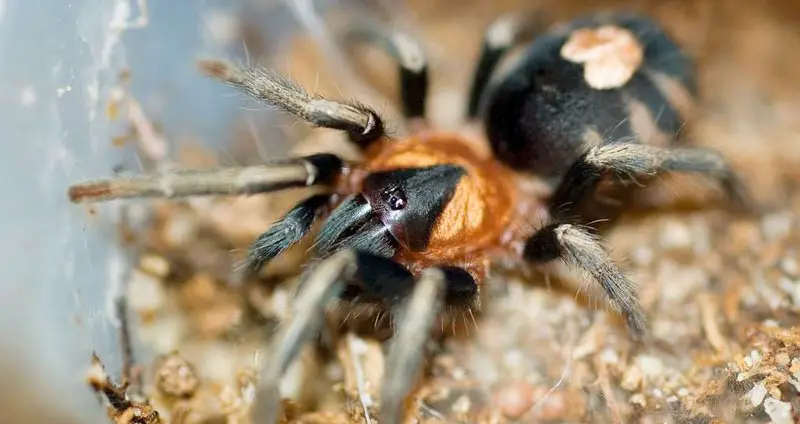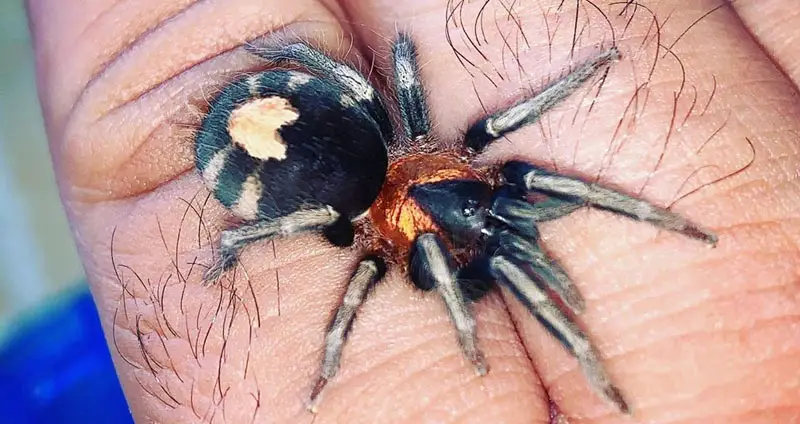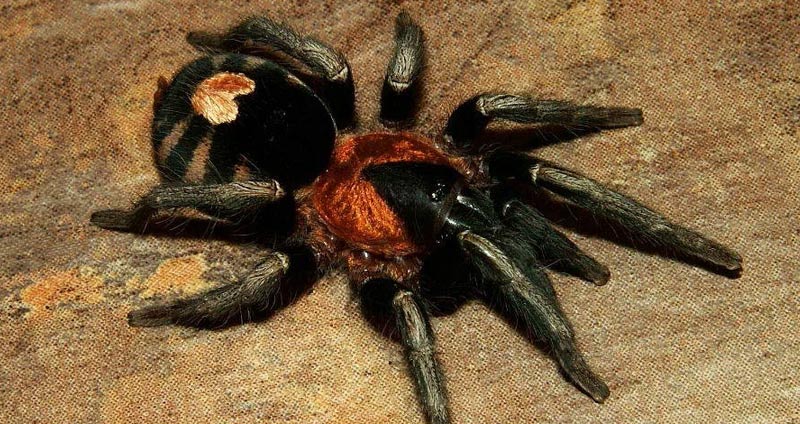When there are more than 800 different species of tarantulas existing all across the globe, you are bound to find some specific species that are more peculiar than others. So is the case with the Cyriocosmus elegans, otherwise known as the Trinidad Dwarf Tiger tarantula.
Whether you have a mild curiosity in spiders or are a full-on arachnid collector, then you definitely want to read this guide on the C. elegans to learn about its dietary needs, behavioral observations, and enclosure recommendations.
Table of Contents
Cyriocosmus elegans Care Sheet
Common Name |
Trinidad Dwarf Tiger |
Species Type |
New world terrestrial |
Habitat |
Found in different countries in South Africa, such as Venezuela, Tobago, and Trinidad. Their habitat has thick rain forests that feature long periods of heavy rain and intermittent periods of dryness. |
Growth Rate |
Fast growth rate. It’s possible for one of these tarantulas to reach maturity in about a year. |
Adult Size |
This is an extremely small tarantula, only achieving a maximum legspan of about 2″. |
Lifespan |
Females live between 5 and 7 years, while males live for about 3. |
Enclosure |
The enclosure can be quite small, but should have several inches of substrate for burrowing. A water bottle and small hide should also be present on the substrate. |
Temp/Humidity |
78°F to 83°F with about 70% to 85% humidity. |
Diet |
Good eater given its smaller size. Can be fed about 2 half-inch crickets per week, supplemented with a few mealworms. |
Temperament |
A docile species that prefers to hide in its burrow over displaying a threat pose or flicking hairs. Doesn’t move too quickly, but can be skittish when nervous. |
Experience Level |
Beginner – A simple and fun tarantula to care for. Doesn’t have a dangerous temperament and has needs that are easy to meet. |
Average Cost |
Slings ~ $40-$50, Males ~ $80-$100, Females ~ $100+ |
Cyriocosmus elegans Appearance
Given the “Dwarf” in its nickname, you would be correct in assuming that the Cyriocosmus elegans is a fairly small spider. Extremely small, in fact, only growing up to 2 inches at most, including leg span.
Spiderlings are usually 1/16” to 1/8” of an inch and may reach 1.5 inches towards maturity. A C. elegans tarantula will reach maturity at a fast pace around 10 to 12 months, but this is offset by a shorter lifespan of only 5 to 7 years.
Aside from its small size, the “Tiger” part of its nickname alludes to its color scheme. This spider is often seen with a black and copper-orange tint pattern, with a hairless, upside-down, orange heart residing on its primarily black, upper abdomen.
You may also notice three white stripes running parallel on the sides of its abdomen, thus also contributing to the “Tiger” nickname, and the legs appearing as a white or a light orange hue.
For such a small spider, these colors are very well-defined and still make it an excellent spider to look at and appreciate all of its intricacies.

Cyriocosmus elegans Temperament
Cyriocosmus elegans is a rather docile species with a small temper that matches its extremely small body size. This small size and calm demeanor makes for a tarantula that can be carefully handled, observed, and just appreciated without a hassle.
Also considering the fact that this species tends to make exaggerated movements while feeding and webbing, it’s all-around a very fun species.
Although it’s a new world spider that has the capability to shed its prickly urticating hair and launch them directly at predators, this arachnid will instead choose to run to its burrow instead of facing against its foes.
They can still pack a punch with a well-placed hair flick, but they seem to know that their size makes them easy prey. If you get extremely close and rowdy, though, they may give you an extremely painful yet ultimately harmless bite.
Many owners love this tarantula because it’s very interactive. They can be carefully handled on occasion due to their slower movements and easy-to-handle size.
It’s also extremely fun to feed this species as they’re more than willing to take down a cricket almost double its size (although that isn’t recommended). Note that some specimens will be more speedy and aggressive than others, so take the time to know yours!
As previously mentioned, this spider is a bit of a burrower, making small, surface level burrows given its size. While it is a burrower, it tends to spend a good amount of time outside of its burrow and exploring its enclosure.
Once again, this makes it very interesting and helps it take on the role of a display tarantula.
Housing Cyriocosmus elegans
The Cyriocosmus elegans does not have a lot of necessary accommodations that need to be made for its enclosure. The main factors you will need to take into account are the size of enclosure, heating, and humidity — all of which are pretty standard!
Optimal Enclosure
As tarantulas come in a variety of sizes, you must take into consideration the variety of enclosures available and their features when housing your tarantulas. In this instance, a tarantula as tiny as the Cyriocosmus elegans will not require a large terrarium.
Additionally, as they’re a terrestrial species, they’ll need a terrestrial enclosure. This entails plenty of floor space with enough depth to contain several inches of substrate.
For this dwarf tarantula species, a smaller enclosure like the Exo Terra 8″ x 8″ x 8″ terrarium is perfect. It’s still plenty big for this small species, and it’s also very secure and has good ventilation.
Enclosure Decorations
Inside of the enclosure, Cyriocosmus elegans requires a few essential supplies in order to feel comfortable. Nothing extreme, though.
First, you need to layer about 3 inches of moisture-retaining substrate on the bottom of the enclosure. This allows for burrowing, in addition to keeping the enclosure cleaner and humid.
Coconut fiber substrate works well for this.
Then, on top of the substrate, you need to include both a tarantula hide and a water dish.
The hide will provide C. elegans with a safe, comfortable spot to hide out in, and the water dish works to fight against dehydration and also contributes to the humidity of the enclosure.
Once you have those accessories added, you can round it out with some sphagnum moss, fake plants, and small rocks.

Enclosure Temperature/Humidity
C. elegans is usually found in warmer countries of South Africa, such as Venezuela, Tobago, and Trinidad. These countries have thick rain forests with periods of heavy rain and dry seasons, so the Trinidad Dwarf Tiger is most accustomed to higher temperatures and areas with a lot of moisture.
To achieve the same type of qualities for your arachnid’s enclosure, we suggest keeping the temperature between 78°F to 83°F and a humidity level at 70% to 85%.
Room temperature would also be suitable for this species, but if their enclosure regularly drops below about 75°F, you’ll need to provide supplemental heating through either a space heater or a gentle heat lamp that doesn’t emit light.
As for humidity, this can be maintained by keeping a full water dish in the enclosure and by misting down the substrate about 3 times per week
It’s recommended to use a thermometer/hygrometer to monitor the temperature and humidity so that you can make changes as needed.
Diet
Although the Cyriocosmus elegans may be smaller than your average tarantula, it still enjoys a hearty meal! This insectivore feeds on a variety of bugs, such as fruit flies, cockroaches, and crickets.
Young C. elegans should be fed flightless fruit flies so that it has an easier time with consumption, for it has not fully developed hunting instincts. As it grows larger (about a half inch to a full inch), you can start feeding it small, pinheaded crickets and dubia cockroaches.
This arachnid has an interesting hunting method where it uses its webbing as a tripwire to alert them to unsuspecting prey, so get creative when feeding your C. elegans! Also, always be sure to feed your Trinidad Dwarf Tiger weekly and clean out its water dish regularly.
Health Concerns
The Cyriocosmus elegans is not a complicated species of tarantula to care for, as it will spend most of the time underground. If you notice that your spider is not eating for any reason, remove the insects from the enclosure for 1 to 2 days, as the C. elegans may be beginning its molting stage.
Sometimes, tarantulas face natural complications when molting and need assistance to complete the molt. Thankfully, online communities of spider owners have guides available for you to follow if you need help with expediting your tarantula’s molting process.
Tarantulas can also have problems with dehydration and mites/parasites, but they’re ultimately quite easy to solve.
Cyriocosmus elegans For Sale & Price
The unique patterns on such a small creature make it quite an interesting and highly sought out spider for most collectors. Luckily, there are online communities dedicated to providing collectors with the information and means of purchasing a Trinidad Dwarf Tiger.
For example, Josh’s Frogs is one such site that has the Cyriocosmus elegans available for as low as $40.
The small size of the Cyriocosmus elegans makes it a low maintenance addition to any spider-owner’s collection. Its small size allows it to fit in most vials, and you seldom must clean its enclosure, as it makes little mess out of its food and underground burrow.
For such a low price-point, ease of maintenance, and stunning coat, you cannot go wrong in making the Trinidad Dwarf Tiger another member of your collection!

